Murad I
| Murad I | |||||
|---|---|---|---|---|---|
| |||||
Savci Bey | |||||
| |||||
| Dynasty | Ottoman | ||||
| Father | Orhan | ||||
| Mother | Nilüfer Hatun | ||||
| Religion | Sunni Islam | ||||
| Tughra |  | ||||
Murad I (
Murad I
Titles
According to the Ottoman sources, Murad I's titles included Bey, Emîr-i a’zam (Great Emir), Ghazi, Hüdavendigâr, Khan, Padishah, Sultânü’s-selâtîn (Sultan of sultans), Melikü’l-mülûk (Malik of maliks), while in Bulgarian and Serbian sources he was referred to as Tsar. In a Genoese document, he was referred to as dominus armiratorum Turchie (Master lord of Turks).[4]
Wars


Murad fought against the powerful
Battle of Kosovo

In 1389, Murad's army fought the Serbian Army and its allies under the leadership of Lazar at the Battle of Kosovo.
There are different accounts from different sources about when and how Murad I was assassinated. The contemporary sources mainly noted that the battle took place and that both Prince Lazar and the Sultan lost their lives in the battle. The existing evidence of the additional stories and speculations as to how Murad I died were disseminated and recorded in the 15th century and later, decades after the actual event. One Western source states that during the first hours of the battle, Murad I was assassinated by Serbian nobleman and knight Miloš Obilić by knife.[5][6] Most Ottoman chroniclers (including Dimitrie Cantemir)[7] state that he was assassinated after the finish of the battle while going around the battlefield. His older son Bayezid, who was in charge of the left wing of the Ottoman forces, took charge after that. His other son, Yakub Bey, who was in charge of the other wing, was called to the Sultan's command center tent by Bayezid, but when Yakub Bey arrived he was strangled, leaving Bayezid as the sole claimant to the throne.
In a letter from the Florentine senate (written by Coluccio Salutati) to the King Tvrtko I of Bosnia, dated 20 October 1389, Murad I's (and Yakub Bey's) killing was described. A party of twelve Serbian lords slashed their way through the Ottoman lines defending Murad I. One of them, allegedly Miloš Obilić, had managed to get through to the Sultan's tent and kill him with sword stabs to the throat and belly.[8][page needed]
Murad's internal organs were buried in Kosovo field and remain to this day on a corner of the battlefield in a location called
Family
He was the son of Orhan and Nilüfer Hatun, a slave concubine who was of ethnic Greek descent.[10]
Consorts
Murad I had at least seven consorts:[11][12][13][14][15]
- Gulçicek Hatun. Slave concubine, mother of Bayezid I.
- Fülane Hatun. Daughter of Ahî Seyyid Sultân, married Murad in 1366.
- Paşa Melek Hatun. Daughter of Kızıl Murad Bey.
- Fülane Hatun. Daughter of Constantine of Kostendil, she married Murad in 1372. Two of her sisters married two of Murad's sons, Bayezid I and Yakub Çelebi.
- Kera Tamara Hatun. Bulgarian princess, daughter of Tsar Ivan Alexander of Bulgaria. Renowned for her beauty, she was forced to marry Murad when he conquered Bulgaria, in 1378.
- Fülane Hatun. Daughter of Cândâroğlu Süleyman II Paşah, she married Murad in 1383.
- Maria Hatun. Born Maria Paleologa, she was the daughter of the Byzantine emperor John V and his wife Helena Kantakouzene. She married Murad in 1386, while two of her sisters married Murad's sons Bayezid I and Yakub Çelebi.
Sons
Murad I had at least five sons:[11][12][14][15]
- Bayezid I (1360 - 1403) - with Gulçiçek Hatun. Ottoman Sultan.
- Yakub Çelebi (c. 1362 - 20 June 1389). Drowned on Bayezid's orders.
- Savci Bey (c. 1364 - November 1385). Executed by his father after he rebelled against him. He had a son, Davud Murad Bey, who fled to Hungary when his father died.
- Ibrahim Bey (c. 1365 - c. 1385). Buried in the Osman I mausoleum.
- Yahşi Bey (? - before 1389) - with Gülçiçek Hatun.
Daughters
Murad I had at least five daughters:[12][14][15]
- Mehmed II Bey (1379 - 1423), Alaeddin Ali II Bey (1381 - 1424) and Oğuz Bey (probably died in infancy). Widowed in 1397, she returned to live in Bursa, but on the death of Bayezid I returned to Karaman, where her eldest son assumed the throne.
- Özer Hatun. Married with issue. Her grandson Mehmed Bey held a post at court in 1426.
- Erhundi Hatun. She married Saruhânoğlu Hızır Bey before 1389.
- Mihriali Devlet Sultan Hatun. She married Karamânoglu Turgut Bey, by whom she had a son, Mahmud Bey.
- Nilüfer Hatun. She built a mosque at Bursa.
Further reading

- Harris, Jonathan, The End of Byzantium. New Haven and London: Yale University Press, 2010. ISBN 978-0-300-11786-8
- ISBN 978-1-1370-1406-1.
References
- ^ "Murad I". TheOttomans.org.
- ^ a b c "Murad I". Encyclopædia Britannica Inc., 2014. Web. 19 Dec. 2014.
- ^ "In 1363 the Ottoman capital moved from Bursa to Edirne, although Bursa retained its spiritual and economic importance." Ottoman Capital Bursa. Official website of Ministry of Culture and Tourism of the Republic of Turkey. Retrieved 19 December 2014.
- ISBN 978-975-389-458-6.
- ^ Helmolt, Ferdinand. The World's History, p.293. W. Heinemann, 1907.
- ISBN 0-472-08260-4.
- ^ Cantemir, Dimitrie, History of the Growth and Decay of the Osman Ottoman Empire, London 1734.[page needed]
- ISBN 9789992287552.
- ^ "Meşhed-i Hüdavendigar – www.sultanmurad.com" (in Turkish). Retrieved 2019-01-14.
- ISBN 0-7914-5636-6.
- ^ a b Nikolay Antov - The Ottoman Wild West
- ^ a b c Mustafa Çağatay Uluçay - Padişahların Kadınları ve Kızları
- ^ Jennifer Lawler - Encyclopedia of the Byzantine Empire
- ^ a b c Necdet Sakaoğlu - Bu Mülkün Kadın Sultanları
- ^ a b c Yılmaz Öztuna, Devletler ve Hanedanlar Cilt 2
External links
![]() Media related to Murad I at Wikimedia Commons
Media related to Murad I at Wikimedia Commons
- . Encyclopædia Britannica. Vol. 19 (11th ed.). 1911. p. 14.

